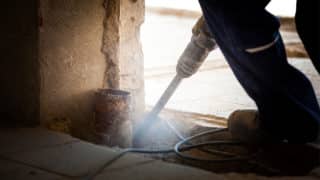Posted on October 21, 2019
Downtime: Flange vs. Grooved Pipe Joints
If a flanged connection was forced into alignment during initial assembly, the ends will need to be separated to access the joint and replace the flange gasket. Flanged separators – hydraulic tools – are available to pry flanges apart. But the larger a flange is, the harder it is to separate. Depending on how much misalignment was overcome during initial assembly, this creates stresses within the piping such that the flanges can cold spring back to their original position upon removal of the bolts.
Flanged pipe joining also employs a series of bolts and nuts to compress a gasket to a very high load between two flange faces, causing the gasket to adhere to one or both flanges. Ultimately, creating permanent deformation. Every time the gasket is damaged, it will have to be scraped off both flange faces to prevent damage to the sealing surface. The gasket will have to be replaced with a new one, again increasing downtime and thereby cost.
Flange Pipe Joints Create More Downtime on Projects
During installation, bolts and nuts of a flanged pipe joint require tightening in a star pattern with specific torque requirements. It’s necessary to have an equal load during bolt-hole alignment, which is time-consuming in comparison to Victaulic’s pad to pad visual inspection and in some cases, no torque requirements. For piping system access, retrofit or expansion, flanging is not the ideal solution.
The same time-consuming bolt-tightening sequence required upon initial installation is also required upon reassembly of the flange. Once realigned, bolted flange pipe joints unfortunately do not provide visual confirmation of proper installation. Filling and pressurizing the piping system is the only measure to ensure there is no flange joint failure. To accommodate piping system vibration and reduce noise, flanged pipe joint systems employ products such as rubber bellows or braided flexible hoses. These flanged specialty products require periodic inspection and replacement if there is any evidence of cracking or bulging. Failure to perform this regular maintenance may result in a product failure and unscheduled emergency downtown and water damage.
What Do I Use to Avoid Flange Downtime? Grooved Pipe Couplings and Fittings
Avoid flange downtime with the ease and speed of maintenance from grooved pipe couplings. Projects are more likely to be done on schedule because it’s faster and easier for maintenance teams, providing better system operating efficiency. When properly maintained, less energy is consumed. In turn, making owners happy.
The same characteristic of grooved joined piping systems that accelerates installation—fewer bolts, easier pipe end alignment and no torque requirements — also makes system maintenance a quick and simple task. Unlike a bolted flange joint that can put variable stress on the gasket, nuts, and bolts, a grooved pipe coupling holds the gasket in precise and uniform compression which ensures positive sealing.
When piping needs to be moved, rotated, changed or added to, a grooved pipe coupling makes this task much more efficient than a bolted flanged joint, which always has more bolts than a grooved coupling. For example, to gain access to an 8-inch strainer basket for cleaning, the grooved coupling only requires the removal of two bolts and the gasket is reused. Whereas a flange joint would require the removal of eight bolts, removal and replacement of the gasket and then timely reinstallation of the bolts. For these reasons, grooved pipe couplings are the best method of joining pipe when minimizing system downtime is critical.
Check out our other post in this two-part series, Why Not to Use Flanged Pipe Joints, to learn why grooved pipe couplings are the best method for joining pipe When Construction Schedules Are Tight.



